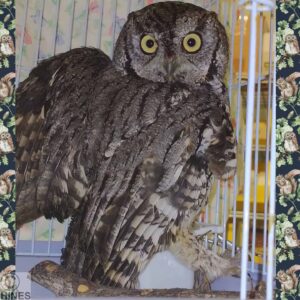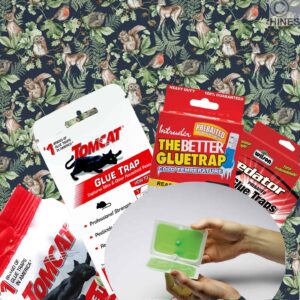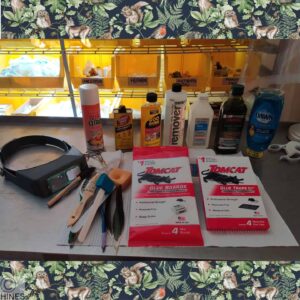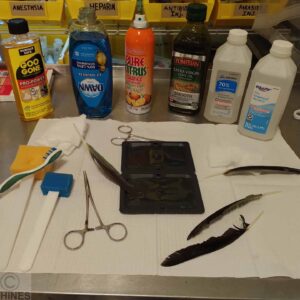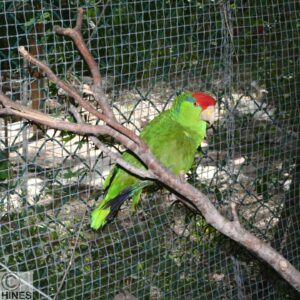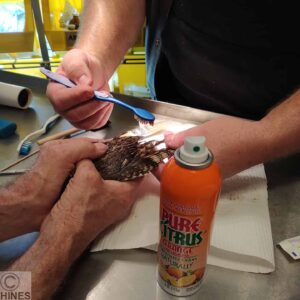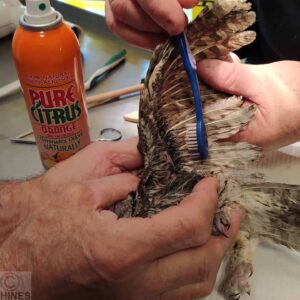TomCat And Other Rodent Glue Traps And Wildlife – What To Do When The Two Of Them Meet
Ron Hines DVM PhD
The only products I know of that appear safe to use on animals to remove glue trap glues are the citrus oil product pictured, olive oil and Dawn® dishwashing liquid. Don’t use any of the other products you see in these photographs or mentioned in this article. All vegetable and mineral oily products or soap/detergent residue used must be completely removed before a bird can return to normal flight. After such treatments, a bird’s feathers have lost their natural waterproofing properties. waterbirds will sink and songbirds will chill. Those natural avian oils take time to replace. RSH
A few weeks ago, a couple arrived at my house with a screech owl in a pet carrier. They had a mouse problem at their home, went to Walmart, bought some TomCat glue boards and set them up on their outside patio. They didn’t want their indoor dog or toddlers to get stuck in them. Well, the following morning they had caught a mouse. However, a screech owl got up before them, spied the mouse and got its wings tangled in the sticky glue as well. Some of the glue they had removed with Dawn™ dishwashing detergent before they brought it to me. But the wing feathers were still sticky – certainly too gummy for the owl to successfully hunt. I called the Company, and they suggested that repeated applications of olive oil followed by Dawn™ dishwashing detergent would remove the glue residue. This screech owl only weighed 5 ounces. It collapsed from stress during the process and I thought that at one point I might lose it.
I needed to find a better way. So, the next day, I went to Walmart and bought a package each of the two mouse size stickies that they sold, traps and boards. I had never used these products. They are exceedingly sticky. After you touch the surface with your finger and attempt to let go, the glue follows you as if it had a mind of its own. The packages said both contained eugenol to enhance stickiness. Eugenol is also an anesthetic and pleasant-smelling essential oil; perhaps they also added it to console the mouse as well. I downloaded the MSD sheet on the product.
It does not indicate what the ingredients are – only that they are considered non-toxic, has a petroleum odor and is non-irritating to the skin. Obviously, whatever compounds are in it, its main ingredient is a pressure sensitive adhesive (PSA) https://en.wikipedia.org/wiki/Pressure-sensitive_adhesive, something with properties similar to Gorilla tape. The main sticky ingredient in many sticky mousetraps are polyisobutene and petroleum resins. Some have sticky plant sap (terpenes) added as well. Polyisobutene is in a lot of the products you are familiar with. It is the sticky in hair removal (epilating) agents. It is on the back of sticky notes. It’s an ingredient in lipstick to keep it from running down your face or smearing. It’s the sticky on many masking tapes. (read here)
I live in tropical Texas adjacent to Mexico. Wild Parrots have always lived here. (read here) When people bring me injured ones, most I can eventually release. But a few I get are not able to live on their own again. I took a handful of the feathers they had shed to try out some products on the glue boards, pressing each feather firmly against the sticky and then pulling the off with the glue residue attached.
OUT OF CURIOSITY, I TRIED TO REMOVE THE RESIDUE FROM SOME SAVED PARROT FEATHERS WITH A NUMBER OF PRODUCTS – MANY OF WHICH YOU SHOULD NEVER APPLY TO A LIVING ANIMAL:
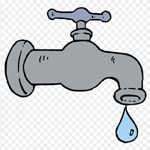
First off, warm tap water on sticky feathers has no effect on the glue.
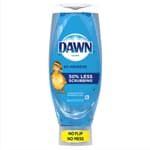
Dawn™ dish washing detergent does not dissolve this glue. At the best, when brushed in or wiped, it will get between the feathers and the glue breaking the bond and allowing the glue to be wiped off into paper towels and discarded. But feathers still remain sticky. Dawn™ may be great for oil spill-contaminated birds. But it only eliminated the stickiness of the glue until the detergent is washed off. If you touch a white paper towel to the feathers, lint will remain clinging to the affected feathers. The end result should be that there is absolutely no stick to your fingertip or towel lint clinging to the feathers.
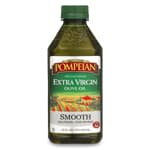
Olive oil had that same effect as Dawn™. The glue just stays in lumps when placed in a bowl of olive oil – even when stirred or mashed. However, coated with oil, the glue can be herded around and much of it can be wiped from the feathers along with the oil. Just keep tearing off sheets of paper towels, caressing the bird with them, wadding them up and pitching them into a trash can.
The TomCat Company did not specify how many repeat washings with Dawn™ and olive oil were required. Perhaps many repeated application of the oil and then the detergent would had made the final results satisfactory. You could probably attempt that with an obliging house pet, but handling is very stressful to wild creatures. Larger animals could be safely anesthetized for the process. I frequently do that with either ketamine, propofol or isoflurane. But safe drug doses in tiny stressed creatures are very hard to quantify.
The other “goo off” products you see in the photo had a more dramatic effect on releasing the glue. None dissolved it. But none of those products would be safe to apply to an animal.
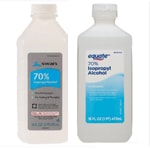
Isopropyl Alcohol had no ability to soften or remove the glue from the old parrot feathers. It is toxic when inhaled or ingested.
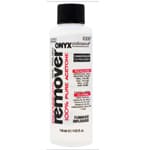
Nail polish remover is primarily acetone. It had no ability to soften or remove the glue from the old parrot feathers. I would never expose a living creature to acetone because it is toxic.
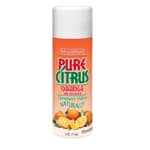
I have a neighbor named Elon. He shoots rockets up from what was my favorite beach. In a chance conversation, one of his employees mentioned that a product containing citrus oil and manufactured by 3M was great for removing sticky adhesive labels. The hazard label on the product says, “extremely flammable, no smoking, no sparks, do not breathe vapors, wear protective gloves, eye protection, remove contact lenses, use in well-ventilated places and at high temperatures the can might explode” – a product definitely not for my use. But I noticed that it was composed of 80% of a proprietary (secret) citrus extract. The other 20% was propane gas (probably why it explodes).
Then, strictly by coincidence, passing the fragrances counter at Walmart, I noticed spray cans of Pure Citrus Orange Air Freshener, 4oz. Orange Scented Non-Aerosol Air Freshener @ $4 .88/4 oz can. The label said 100% natural oils extracted from fresh oranges. It mentioned that it was great for spraying in and around your cat’s litter box. However, it did note that it was not animal-tested. Perhaps they just meant that it was eco-friendly, and no rabbits were sacrificed. It seemed to me that it might be a good candidate. I sprayed it on the very sticky parrot feathers and presto, 3 minutes later the now non-sticky glue wiped right off.
The next day the SpaceX guy, the one you see with the toothbrush wiped off the sticky feather areas on the owl. It’s my hands just holding an consoling the owl. We were careful to hold the spay nozzle close to the feathers, not press too hard on the nozzle and apply the liquid to the feathers not the skin. Then a quick rinse with diluted Dawn™, a warm tap water rinse, some paper towel pat downs and a blow dry. It is quite easy to overheat skin using a human blow-dryer. Your hand needs to be directly in the airflow so that you feel the heat when it is too hot. The animal blow driers that groomers use rely more on volume than temperature to dry pets.
Just because a product claims to be all-natural doesn’t necessarily mean that it is non-toxic. There are many natural toxins. Animals and plants often contain them to discourage being eaten. Such is the case with some essential oils. D-limonene, another extract of citrus peels, has been known to be toxic, particularly in cats. (read here) Essential oils smell nice. Many folks puff them around their house or introduce their aroma with vapor diffusers. Oils have the ability to be absorbed through the skin and reach the bloodstream eventually reaching the liver and kidneys sometimes producing damage. That is particularly true in cats – probably because they are deficient in liver glucuronosyltranferase enzymes. (read here) How essential oils affect birds is unknown, but with their large air sac absorption area it is likely that these products would be highly absorbed as they breathe. If you utilize them with birds, I suggest that you do so in a very windy environment or in front of a fan and never on an animal already in respiratory distress. Anyone with asthma or other breathing difficulties should stay away from these products because they can be quite inflammatory to the lungs.

Three days ago, I gave the owl a large supper at sunset, left its flight cage door ajar, and in the morning it was gone. Last night and the night before, I refilled its food and water bowls. Most of the screech owls and barn owls that my wife and I raise from babies come back for a time after release. This one didn’t. I wish it well.
You are on the Vetspace animal health website
Visiting the products that you see displayed on this website help pay the cost of keeping these articles on the Internet.

